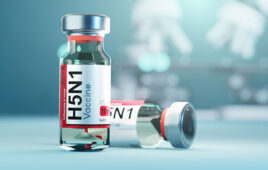Aesica Pharmaceuticals is planning to establish a new, dedicated facility for its inhalation development and manufacturing services at the company’s Nottingham, U.K. location. The center is an effort to capitalize on the company’s recent advances in this area of formulation and drug delivery, advances which they believe could help pharmaceutical companies that currently aren’t served very well the inhalation development community.
“If you spoke with me eight or nine years ago, I would have said the inhalation market had reached the saturation point,” says Jonathan Faulkes, business development manager for inhalation products at Aesica. “But Boehringer Ingelheim’s ipratropium bromide really opened up the COPD market. The COPD market has the potential to be absolutely huge.”
Chronic obstructive pulmonary disease (COPD) is characterized by a difficulty in breathing that worsens over time. The disease is caused by smoking or long-term exposure to industrial pollutants.
Although those causes are on the decline in the Western world, the opposite is true in developing countries, including Brazil, Russia, India and China (BRIC). In these nations, people with higher incomes are exploring luxury products such as cigarettes, and governments have yet to establish air-quality standards in their industries.
All of these factors point to an increasing market for COPD therapeutics, and one of the most effective way to delivery these treatments to lung tissue is inhalation.
“We’re also getting an increase in the administration of non-COPD antibacterial treatments for lung infections related to cystic fibrosis (CF),” says Faulkes. For example, Savara Pharmaceuticals has recently received $1.7 million from a nonprofit organization to develop an inhaled antibiotic to treat people with CF with persistent methicillin-resistant Staphylococcus aureus (MRSA) lung infections. “And there’s quite a bit of talk about oncology, especially for non-small cell lung cancer where you can directly impact the tissue and reduce side-effect profiles quickly.”
Of course, not every drug is ideal for inhalation. For example, several years ago, many pharmaceutical companies were developing insulin inhalation products. Although some of these products remain in development, such as MannKind’s inhalable insulin Afrezza, which is currently being reviewed by the U.S. Food and Drug Administration, most of these products were abandoned because they would cost more than the already well-accepted autoinjectors and pens developed for insulin delivery.
“That was a horrendous mistake for inhalation development,” says Faulkes. “But CF products and gene therapy drugs would be fantastic to go through the lung. And we have clients coming with peptides who want an easier way to get the peptide into the body other than injecting it.”
Inhalation development is a highly specialized skill and often quite expensive, but Aesica is hoping to lower those barriers for small universities and medium pharmaceutical and biotech companies. To do so, Aesica has spent the past five years developing their inhalation services.
One of their most recent advances came through a partnership with 3P Innovation Ltd. (Warwick, U.K.), which has developed the Fill2Weight system for powder filling. The system allows for quick, robust capsule filling.
“It’s a high-quality, high-throughput system,” says Faulkes. “[It provides] a lot more capsules for a given time, and we have 100 percent weight check-in to make sure of the correct dosage. This technology is a really quick, clever solution without the compaction that you would normally get with capsule-filling technology.”
And because Aesica doesn’t sell a commercial inhalation device itself, Faulkes believes that the company is in a unique position to help pharmaceutical companies who have their own device. “Aesica is device-neutral, so we can develop a company’s device and formulation, and then push them into development and then into commercial.”
Filed Under: Drug Discovery




